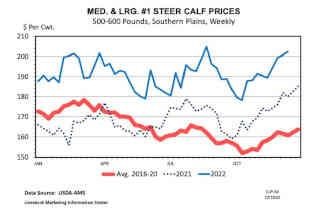By James Mitchell
This year was challenging for the livestock and poultry industries. High input prices, including agricultural chemicals, farm labor, feed, and fuel, raised the cost of production. Severe drought led to accelerated herd liquidation and poor hay production for cattle producers. Logistical and transportation issues continue to pressure agricultural supply chains. Highly pathogenic avian flu has negatively impacted poultry and egg production. Despite these challenges, U.S. red meat and poultry production is projected to reach a record 107.5 billion pounds in 2022 (Dec WASDE).

The Livestock Marketing Information Center (LMIC) estimates 2022 cash costs for cow-calf producers at $963/cow or 13% higher year over year. The largest expenditure for cattle producers is harvested forage and feed. LMIC’s 2022/2023 season-average hay price is $160/ton, an increase of 9% compared to the 2021/2022 season-average price. Poor growing conditions this summer and expensive inputs contribute to these record-high hay prices. LMIC’s 2022/2023 average corn price is $7.00/bu, an increase of $1/bu compared to their 2021/2022 corn price. Feed costs tend to follow the corn market, and we will not see cheaper corn until at least the 2023/2024 marketing year.
Major cattle production regions have dealt with widespread drought since mid-2020. The Southeast has mostly avoided significant drought impacts. However, conditions this summer deteriorated rapidly. For example, in late June, only 15% of Arkansas pastures were rated as poor or very poor. By late July, USDA estimated that 75% of Arkansas pasture and range was poor or very poor. The rapid decline and pasture conditions brought large numbers of cows to market in the Southern Plains and Southeast.
Federally inspected beef cow slaughter will finish 12% higher year over year. Through 48 weeks, national beef cow slaughter totals 3.58 million head, and is the highest since 1996. Regionally, beef cow slaughter in Region 6 (AR, LA, NM, OK, & TX) totals 1.02 million head and represents 28% of the national total. These large slaughter totals will significantly affect cattle inventory numbers that USDA will release in January. We will see further tightening of cattle supplies and increasing prices in 2023.
Cattle markets improved in 2022, with prices at their highest since 2014-2015. In the Southern Plains (SP), fed steer prices averaged $141/cwt, an increase of $20/cwt compared to last year. SP prices for 500-600 pound steers averaged $191/cwt or 13% higher year over year. Despite large volumes of cull cows at markets, SP prices for 85-90% lean slaughter cows averaged $63/cwt, an increase of 17%.
This will be the last CMN article this year. We’ve had fun writing these articles and look forward to writing more next year. Thank you to everyone who reads and subscribes to CMN. Merry Christmas and Happy New Year!
Source : osu.edu